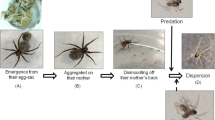Summary
Effects of starvation on the suryival period and the respiratory rate in adults of a wolf spider,Pardosa astrigera (L. Koch), were investigated. The spiders used were divided into four groups: well-fed, starved and two limited food groups; in the latter two, each spider was supplied with one leafhopper every second or third day. Adult males and females ofP. astrigera could survive for a long time; 28.8±2.7 days and 54.4±18.9 days, respectively, without any food. The longevities shown here were 73.8% for males and 78.6% for females of those of well-fed spiders, indicating thatP. astrigera adults have a strong tolerance to starvation. The respiratory rate of well-fed adults showed no tendency to increase or decrease with their aging; the mean respiratory rates were 4.86×10−4 mg CO2/mg f.w. (fresh body weight)/hr for males and 3.80×10−4 mg CO2/mg f.w./hr for females. The respiratory rates of starved spiders increased during the first two days of starvation but decreased markedly from the third to the twelfth day, and thereafter retained an almost constant level for each sex. The mean respiratory rates after the twelfth day of starvation were 2.49×10−4 mg CO2/mg f.w./hr for males and 2.76×10−4 mg CO2/mg f.w./hr for females; these values were respectively 48.4% and 63.0% of those prior to starvation. The fresh body weight of starved spiders decreased linearly with time but the rate was small. The respiratory rates of the limited food groups tended to decline with time and thereby their weight losses were minimized. The decrease in the respiratory rate under starvation was considered not to be due to spider exhaustion or senescence but due to an intrinsic change in behaviour and/or metabolism, because when the spiders were supplied with ample food for five days after starvation, the respiratory rate and the body weight rapidly recovered to near the levels prior to starvation. It is suggested that starved spiders use a higher ratio of fat as catabolic substrate than normally fed or satiated ones. Feeding strategies of poikilo-therm predators are discussed.
Similar content being viewed by others
Literature Cited
Anderson, J. F. (1970) Metabolic rates of spiders.Comp. Biochem. Physiol.33A: 51–72.
Anderson, J. F. (1974) Responses to starvation in the spidersLycosa lentaHentz andFilistata hibernalis (Hentz).Ecology55: 576–585.
Campbell, R. C. (1974) [translated byS. Ishii, 1976]Statistics for biologists. 2nd ed. Baifukan, Tokyo, (in Japanese).
Edgar, W. D. (1971) Aspects of the ecological energetics of the wolf spiderPardosa (Lycosa) lugubris (Walckenaer).Oecologia7: 136–154.
Edwards, G. A. (1953) Respiratory metabolism. 96–146. InK. D. Roeder (ed.)Insect physiology. John Wiley and Sons, New York.
Ford, M. J. (1977a) Metabolic costs of the predation strategy of the spiderPardosa amentata (Clerck) (Lycosidae).Oecologia28: 333–340.
Ford, M. J. (1977b) Energy costs of the predation strategy of the web-spinning spiderLepthyphantes zimmermanniBertkau (Linyphiidae).Oecologia28: 341–349.
Giese, A. C. (1966) Lipids in the economy of marin invertebrates.Physiol. Rev.46: 244–298.
Greenstone, M. H. andA. F. Bennett (1980) Foraging strategy and metabolic rate in spiders.Ecology61: 1255–1259.
Griffiths, D. (1980) The feeding biology of ant-lion larvae: prey capture, handling and utilization.J. Anim. Ecol.49: 99–125.
Hagstrum, D. W. (1970) Physiology of food utilization by the spiderTarentula kochi (Areneae: Lycosidae).ann. Entomol. Soc. Am.63: 1305–1308.
Humphreys, W. F. (1977a) Variables influencing laboratory energy budgets ofGeolycosa godeffroyi (Araneae).Oikos28: 225–233.
Humphreys, W. F. (1977b) Respiration studies onGeolycosa godeffroyi (Araneae: Lycosidae) and their relationship to field estimates of metabolic heat loss.Comp. Biochem. Physiol.57A: 255–263.
Inoue, T. andT. Matsura (1975) Mantis: its hunting behaviour.Shizen30: 48–56 (in Japanese).
Itô, Y. (1964) Preliminary studies on the respiratory energy loss of a spider,Lycosa pseudoannulata.Res. Popul. Ecol.6: 13–21.
Ivlev, V. S. (1934) Eine Mikromethode zur Bestimmung des Kaloriengehalts von Nahrstoffen.Biochem. Z.275: 49–55.
Ivlev, V. S. (1939) Effects of starvation on energy transformation during the growth of fish.C. R. l'Acad. Sci. l'USSR (foreign language series)25: 90–92.
Kikuya, N. (1980) Some researches on the inhabitable environment of the liphistiid spider,Heptathela kimuraiKishida in Oita Pref., Kyushu.Atypus No.76: 1–43 (in Japanese).
Kleiber, M. (1975)The fire of life: an introduction to animal energetics. 2nd ed. Robert E. Krieger Publishing Co., Huntington and New York.
Macfadyen, A. (1963)Animal ecology: aims and methods. 2nd. ed., Sir Isaac Pitman and Sons Ltd., London.
Marsden, I. D., R. C. Newell andM. Ahsanullah (1973) The effect of starvation on the metabolism of the shore crab,Carcinus maenas.Comp. Biochem. Physiol.45A: 195–213.
Matsura, T. (1981) Responses to starvation in a mantis,Paratenodera angustipennis (S.).Oecologia50: 291–295.
Miyashita, K. (1968a) Quantitative feeding biology ofLycosa T-insignitaBoes. etStr. (Araneae: Lycosidae).Bull. Natl. Inst. Agr. Sci., Ser. C. No.22: 329–344.
Miyashita, K. (1968b) Growth and development ofLycosa T-insignitaBoes. etStr. (Araneae: Lycosidae) under different feeding conditions.Appl. Ent. Zool.3: 81–88.
Miyashita, K. (1969a) Seasonal change of population density and some characteristics of overwintering nymph ofLycosa T-insignitaBoes. etStr. (Araneae: Lycosidae).Appl. Ent. Zool.4: 1–8.
Miyashita, K. (1969b) Effects of locomotory activity, temperature and hunger on the respiratory rate ofLycosa T-insignitaBoes. etStr. (Araneae: Lycosidae).Appl. Ent. Zool.4: 105–113.
Moulder, B. C. andD. E. Reichle (1972) Significance of spider predation in the energy dynamics of forest floor arthropod communities.Ecol. Monogr.42: 473–498.
Nakamura, K. (1972) The ingestion in wolf spiders. II. The expression of degree of hunger and amount of ingestion in relation to spider's hunger.Res. Popul. Ecol.14: 82–96.
Peakall D. B. andP. N. Witt (1976) The energy budget of an orb web-building spider.Comp. Biochem. Physiol.54A: 187–190.
Phillipson, J. (1966)Ecological energetics. Edward Arnord, London.
Pianka, E. R. (1974)Evolutionary ecology. 2nd ed. Harper and Row, New York.
Tanaka, K. andY. Itô (1982) Different response in respiration between predaceous and phytophagous lady beetles (Coleoptera: Coccinellidae) to starvation.Res. Popul. Ecol.24: 132–141.
Turnbull, A. L. (1962) Quantitative studies of the food ofLinyphia triangularisClerck (Araneae: Linyphiidae).Can. Ent.94: 1233–1249.
Turnbull, A. L. (1964) The search for prey by a web-building spiderAchaearanea tepidariorum (C. L. Koch) (Aranaea: Theridiidae).Can. Ent.96: 568–579.
Turnbull, A. L. (1965) Effects of prey abundance on the development of the spiderAgelenopsis potteri (Blackwall) (Araneae: Agelenidae).Can. Ent.97: 141–147.
Wise, D. H. (1975) Food limitation of the spiderLinyphia marginata: experimental field studies.Ecology56: 637–646.
Yaginuma, T. (1960)Spiders of Japan in colour. Hoiku-sha, Osaka (in Japanese).
Author information
Authors and Affiliations
Additional information
This work was partially supported by the Nippon Life Insurance Foundation Research Fund and Grant-in-Aid (No. 56480039) from the Ministry of Education, Science and Culture, Japan.
Rights and permissions
About this article
Cite this article
Tanaka, K., Itô, Y. Decrease in respiratory rate in a wolf spider,Pardosa astrigera (L. Koch), under starvation. Res Popul Ecol 24, 360–374 (1982). https://doi.org/10.1007/BF02515582
Issue Date:
DOI: https://doi.org/10.1007/BF02515582




